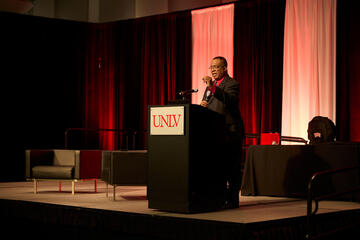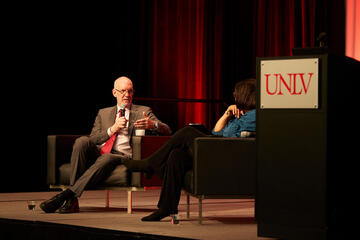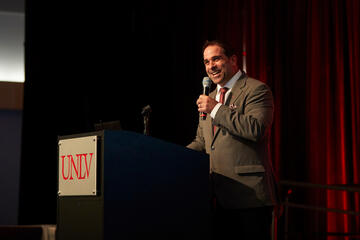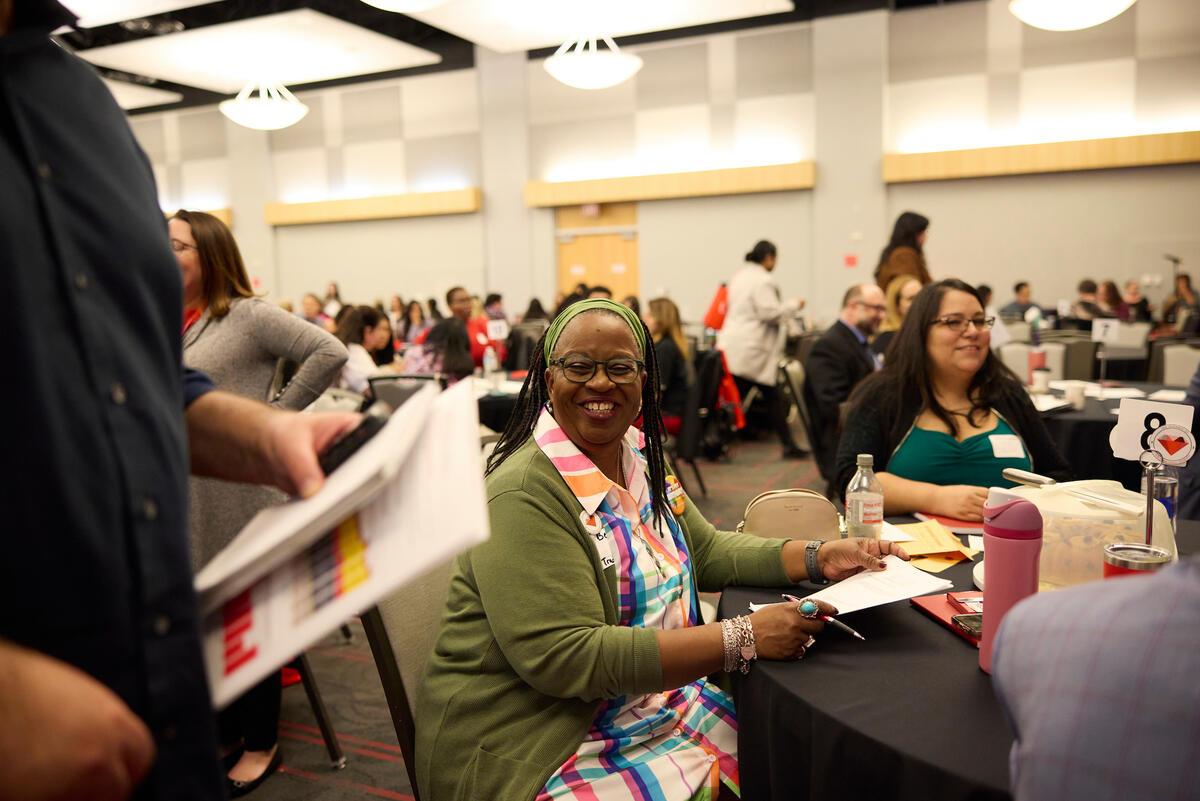Diversity.
For some, it’s a box-checking buzzword. For others, it’s a human resources-inspired initiative that’s at the forefront of many modern industries — including, of course, higher education.
More than anything, though, diversity is a concept of vital importance to those who desire equitability for all. Unfortunately, this seemingly simple concept is often misunderstood — even by those who embrace and try to practice diversity with the best of intentions.
“When we talk about diversity, the question that’s often asked is, ‘Well, who are we talking about?’ — as though diversity refers to just one group or one individual or one identity,” UNLV President Keith E. Whitfield said at the third annual Minority-Serving Institution (MSI) Student Success Summit on March 25.
“Diversity means everybody. It means we bring everybody to the table, and we create equity and opportunities for everyone — not one specific group.”

Whitfield delivered his remarks from the UNLV Student Union Ballroom, which is situated on the east end of an institution that annually ranks as one of the most diverse in the nation.
The U.S. Department of Education has designated UNLV both Title III - Asian American and Native American, Pacific Islander-Serving Institution (AANAPISI) and a Title V - Hispanic-Serving Institution (HSI).
In fact, according to data presented at the MSI Student Success Summit, nearly four of every five students enrolled in the fall 2023 semester identified as non-white.
Two of those students — Beverly Susan Carter and Denise Guardado — were among the more than 200 students, faculty, staff, and administrators who attended this year’s MSI Student Success Summit. The presence of Carter and Guardado underscored Whitfield’s salient reminder that the UNLV’s diversity umbrella is wide and covers numerous marginalized and intersecting groups.
As women of color — Carter is Black; Guardado is Latina — their diversity is clear in two easily identifiable ways. But there’s a third definition of diversity with which Carter and Guardado associate: as nontraditional students, or adult learners. That term can apply to older students; those who are married or are parents; those who work full or part time; and those who only attend nighttime classes.
Carter brought that perspective to the roundtable discussions during the summit, too. “UNLV has always been diverse in the idea of gender and race, as far as I could see,” said Carter, who was 58 when she enrolled as an undergraduate student at UNLV in 2017. “My perspective is that the diversity conversation never included age.”
Carter came to discover that more than 30% of UNLV’s undergraduate population is classified as nontraditional. That spurred her to co-found the Alliance of Non-Traditional Students, which has blossomed from five initial members to more than 400.
Guardado is one of those members. And like “Ms. Bev” — as Carter is known to many — she, too, felt somewhat isolated and overlooked when she enrolled at UNLV in 2020, some 21 years after she graduated high school.
“In one respect, I saw a lot of myself in the campus community, thanks to a noticeable Latino and Latina population,” said Guardado, who wasn’t able to attend in-person classes until COVID-related restrictions were lifted. “But I was also on the older spectrum. I remember attending classes and a professor said, ‘You guys are not old enough to remember this, but…’” And I would think, ‘Uh, actually, yes, I do remember that.’”
During a break from the MSI Student Success Summit, Guardado acknowledged that progress has been made on this particular front. She said professors have begun choosing their words more carefully so as not to disregard the presence of older students.
“I’m starting to notice that professors now will say, ‘Some of you might not remember this …’” Guardado said. “So the language has changed a bit."
That shift is due in no small part to events like the MSI Student Success Summit, said Chris Heavey, UNLV's executive vice president and provost.

"We, as higher ed professionals, have not been a source for equity in this nation for the last hundred years — and that is a really profound thing to ponder," he said, noting the advantages that his college-educated parents gave to him.
"It is crystal clear to me that if we are not thinking about this as a campus — about how to give those advantages to everyone of our students, to those who don’t happen to have parents who went to college and know how to give them guidance — if we’re not doing that in their place, we are not promoting equity.
"Our task is to spread this message so every person, every day thinks about what it means to be equitable."
The summit provided an opportunity to share some of the positive outcomes from various MSI Task Force initiatives. More than that, though, attendees had a chance to help the university build on these successes to become a more student-serving MSI.
For instance, participants were encouraged to brainstorm ideas and recommend actions to propel equity-based practices and close diversity-related gaps in key areas such as graduation rates.
Also, keynote speaker Tia McNair — who serves as vice president of the American Association of Colleges & Universities (AAC&U) — offered practical and evidenced-based strategies designed to help UNLV achieve equity in student-success outcomes and prepare all students to be leaders in the workforce.
The overarching message bridging the daylong event was encapsulated by the title of McNair’s address: “From Equity Talk to Equity Walk: Translating Intent into Practice” (which played off the title of the 2020 book McNair co-authored, From Equity Talk to Equity Walk: Expanding Practitioner Knowledge of Racial Justice in Higher Education).
In other words, ideas, chatter, awareness, and intent are great. But if all those well-intended principles don’t translate into action and accountability, true progress won’t follow.

“If we continue to have opportunity gaps, [such as] our diverse students not completing degrees at the same rates as other student groups, then higher education as a vehicle for social and economic mobility is going to continue to come into question,” said Jeff Orgera, UNLV’s associate vice provost for Student Success who co-hosted the MSI Student Success Summit. “We’ve got to figure this out and get it right. It’s not OK for an industry like higher education to be serving some of its students well and not others.
“It’s like a hospital setting. If you’re only giving care to one group of people, it’s not a very good hospital."
Other highlights of the summit included:
- MSI Grant funding updates — Since the inception of the MSI Task Force in late 2019, UNLV has submitted 118 related grant proposals and been awarded 41 for a total of $21.5 million dollars. Leading the awards are initiatives in Academic Enrichment, the colleges of Education, Sciences and Engineering, and the Schools of Integrated Health Sciences.
- The Alliance of Hispanic-Serving Research Universities — Last year, UNLV became a founding member of the Alliance aimed at boosting Hispanic representation in doctoral students and faculty at member institutions. UNLV’s Hispanic doctoral student enrollment has grown to 17.7% in fall 2023, up from 14.4% two years ago.
- Graduate College Programming — The Graduate College has supported the development of cultural affinity groups to build a sense of belonging. New this year are the Grad Pride Alliance and UNLV Comrades. The Grad College also introduced its My Professional Origin Story speaker series so UNLV faculty and administrators could share their career journeys.
The summit also offered a deeper dive into grant-funded UNLV programs, including:
- National Resource Hub for Culturally Relevant and Responsive STEM Environments,
- Center for Academic Enrichment and Outreach programs,
- UNLV Equity Institute and efforts build through a collaboration with the national Student Experience Project.



